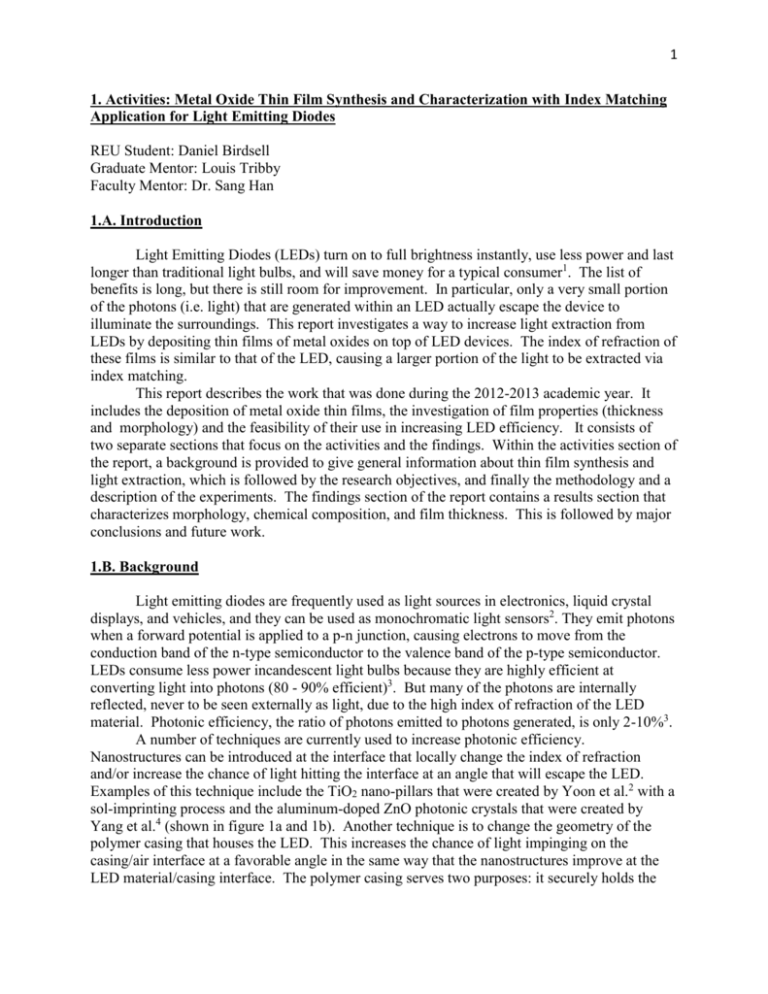Document
advertisement

1 1. Activities: Metal Oxide Thin Film Synthesis and Characterization with Index Matching Application for Light Emitting Diodes REU Student: Daniel Birdsell Graduate Mentor: Louis Tribby Faculty Mentor: Dr. Sang Han 1.A. Introduction Light Emitting Diodes (LEDs) turn on to full brightness instantly, use less power and last longer than traditional light bulbs, and will save money for a typical consumer1. The list of benefits is long, but there is still room for improvement. In particular, only a very small portion of the photons (i.e. light) that are generated within an LED actually escape the device to illuminate the surroundings. This report investigates a way to increase light extraction from LEDs by depositing thin films of metal oxides on top of LED devices. The index of refraction of these films is similar to that of the LED, causing a larger portion of the light to be extracted via index matching. This report describes the work that was done during the 2012-2013 academic year. It includes the deposition of metal oxide thin films, the investigation of film properties (thickness and morphology) and the feasibility of their use in increasing LED efficiency. It consists of two separate sections that focus on the activities and the findings. Within the activities section of the report, a background is provided to give general information about thin film synthesis and light extraction, which is followed by the research objectives, and finally the methodology and a description of the experiments. The findings section of the report contains a results section that characterizes morphology, chemical composition, and film thickness. This is followed by major conclusions and future work. 1.B. Background Light emitting diodes are frequently used as light sources in electronics, liquid crystal displays, and vehicles, and they can be used as monochromatic light sensors2. They emit photons when a forward potential is applied to a p-n junction, causing electrons to move from the conduction band of the n-type semiconductor to the valence band of the p-type semiconductor. LEDs consume less power incandescent light bulbs because they are highly efficient at converting light into photons (80 - 90% efficient)3. But many of the photons are internally reflected, never to be seen externally as light, due to the high index of refraction of the LED material. Photonic efficiency, the ratio of photons emitted to photons generated, is only 2-10%3. A number of techniques are currently used to increase photonic efficiency. Nanostructures can be introduced at the interface that locally change the index of refraction and/or increase the chance of light hitting the interface at an angle that will escape the LED. Examples of this technique include the TiO2 nano-pillars that were created by Yoon et al.2 with a sol-imprinting process and the aluminum-doped ZnO photonic crystals that were created by Yang et al.4 (shown in figure 1a and 1b). Another technique is to change the geometry of the polymer casing that houses the LED. This increases the chance of light impinging on the casing/air interface at a favorable angle in the same way that the nanostructures improve at the LED material/casing interface. The polymer casing serves two purposes: it securely holds the 2 LED and all of its wiring, and it has an index of refraction in between that of the LED material and that of air, which increases light extraction (more detail later). A commercial LED with its casing is shown in Figure 1(c). Figure 1: (a) Atomic force microscopy (AFM) image of TiO2 nano-pillars to locally change index of refraction2; (b) cross sectional view of LED device with Al-doped ZnO photonic crystals and an AFM image of the photonic crystals4; (c) An image of a polymer case used in LEDs5. Note the casing is rounded to increase the proportion of light hitting at a steep angle. Another technique to increase light extraction is called index matching. As shown in Figure 2, light bends at the interface of two materials having different indices of refraction. When moving from high index of refraction materials to low index of refraction materials, some of the light is internally reflected. If the difference in indices of refraction is larger, more light is internally reflected. This light-bending phenomena is described mathematically with Snell's Law in the equation below. Using Snell's Law, the critical angle (θc), or the smallest angle at which light can reach the interface to be internally reflected, can be calculated. To increase light extraction from LEDs, the critical angle must be diminished by decreasing the differences between indices of refraction at the interface. This "matching of indices of refraction is where the term "index matching comes from." 3 Figure 2: (a) Illustrations of Snell's law1 and (b) how index matching can increase LED light extraction by decreasing the critical angle. When light hits the interface between air and the LED at an angle greater than the critical angle it will be internally reflected. In the lower LED setup, a thin film with an intermediate index of refraction allows light that hits the interface at the old θc to escape the LED material. Thin films, chosen for their index of refraction, could be synthesized on top of LEDs to enhance light extraction via index matching. This is illustrated in Figure 2b where light is internally reflected at θc in the top setup but is allowed to escape the LED material after a thin film is placed on the LED in the bottom setup. In theory, this index matching can be extended to multiple thin film layers, each with a slightly smaller index of refraction. Table 1 shows the index of refraction of the species that are commonly used in LEDs, the index of refraction of some of the metal oxides that are synthesized in this study, and the index of refraction of air. A three layer index matching device could consist of ZnO on Anatase on Rutile on a GaP LED. For a photon to escape this LED, it would not need to escape from GaP (n=3.18) straight to Air (n=1.00). Instead, the photon would go through several materials that slowly ramp down the indices of refraction that the photon must pass through (index of refractions in order are 3.18, 2.75, 2.5, 2.0, and 1.0). 4 Table 1 - Index of Refraction of Species in LED Systems Purpose Air Film Film Film LED LED LED LED Species Air ZnO TiO2 (Anatase) TiO2 (Rutile) GaN GaP AlGaInP ZnSe Refractive Index (n) 1.0 2.0 2.5 2.75 2.4 3.18 3.23 2.52 Thin films are defined to be less than several micrometers thick. These films can be deposited using a variety of different techniques. The deposition techniques include dip-coating, spin coating, chemical vapor deposition, electrodeposition, electroless deposition, and atomic layer deposition. In this study, TiO2 is deposited via electrodeposition, and ZnO is deposited with both electrodeposition and dip coating. In electrodeposition, a solid is deposited onto an electrode from an ionic solution. A three electrode setup is used in this study. A potential is applied to the working electrode that sits in an ionic solution. The ions react with and deposit onto the working electrode, forming a film. The auxiliary electrode is there to complete the circuit, and the reference electrode gives a reference potential that is being applied. Electrodeposition generally produces more uniform films than dip coating. Figure 3 shows a three electrode setup in which zinc oxide is deposited onto the working electrode. In dip coating, a substrate is lowered into a solution and then very slowly pulled out of solution. Species within the solution are deposited onto the substrate as the solution dries. Dip coating is advantageous for its simplicity, but the film quality is less than that of electrodeposition. In this case, high film quality means that the film covers the entire substrate (i.e. no pores reaching to the substrate) and that the morphology is smooth. 5 Figure 3: A schematic of a three electrode electrodeposition of ZnO with a chemical formula for aqueous zinc ions reacting to zinc oxide solid on the working electrode. This reaction requires electrons to be passed through the system in what amounts to be an electrical circuit. Of the many characterization techniques that are used in this study, spectroscopic ellipsometry is the most relevant to the investigation. This optical technique provides film thickness and its optical properties, such as complex refractive index. First, polarized light is incident on a film, and the change in intensity and polarization angle for the reflected light is measured. Then, a model is constructed that takes initial guess values for film optical properties and thickness (e.g. if a TiO2 film is being studied, the optical properties of TiO2 are input). From these initial input values, the model prediction is compared to the change in polarization data, and the sum of the error is minimized by changing the modeled film thickness, optical parameters, or both. Ellipsometry is a very powerful tool to measure film thickness and optical parameters, but the results can only be accepted if the model is believed to be true. Figure 4 has figures that explain polarization and ellipsometry. 6 Figure 4: (a) Electromagnetic radiation (i.e. light) that is elliptically polarized because the two waves are neither in phase nor 90 degrees out of phase; (b) a schematic of how light interacts with films. Light may reflect off of the film, enter and penetrate, reflect amongst the internal layers, or any combination of these behaviors. The change in polarization that is measured in ellipsometry must account for all of these possible behaviors6. 1.C. Research Objectives The research objectives of this project are threefold: Firstly, to optimize the synthesis of metal oxide thin films of ZnO and TiO2. Secondly, to investigate film properties including thickness, morphology and optical parameters, all of which can affect the optics and electronics of LEDs and other electronics that utilize thin films. Thirdly, to consider the feasibility of increasing photonic efficiency through index matching using what has been learned about the film synthesis and properties. 1.D. Methodology Films are synthesized using dip coating and electrodeposition. The experimental setups are shown in Figure 5. ZnO films are created by dip coating and electrodeposition; TiO2 is only deposited via electrodeposition. In dip coating, three preliminary solutions are used in the creation of the final dip coating sol. The first is a hexadecyltrimethylammonium bromide (CTAB) solution consisting of 0.520 g. of CTAB, 2 mL of ethanol, and 1 mL of CHCl3. The second is an sodium dodecyl sulfate (SDS) solution consisting of 0.520 g. SDS, 4 mL of methanol, and 1 mL of CHCl3. The SDS solution is heated and placed in a sonicator to ensure that no species precipitate out. The third solution is 85% ethanol and 15% de-ionized water by volume. These three preliminary solutions are combined to make a solution called Sol A. Sol A is composed of 0.65 mL of CTAB preliminary solution, 0.35 mL of SDS preliminary solution, and 1.733 g (approximately 2 mL) of ethanol/water solution. 0.179 g. zinc nitrate is added to Sol A, which results in a colorless, transparent precursor solution. Finally, the zinc precursor solution is diluted with the 85% ethanol and 15% de-ionized water preliminary solution to 1:4 and 1:20 ratios. To dip coat, a 1 cm x 3 cm silicon substrate is cleaned with piranha solution (consisting of sulfuric acid and hydrogen peroxide). It is then dipped into solution and removed at an upward rate of 70 um/sec. 7 Figure 5: These photographs show the process of (a) dip coating and (b) electrodeposition. In electrodeposition, a three-electrode setup is used with either copper or highly-doped silicon as the working electrode (which gets deposited onto). The counter electrode is a platinum mesh, which is not deposited onto but completes the circuit. The reference electrode is Ag/AgCl, and provides a reference voltage so that the deposition voltage is known. Depositions are done in the voltage range of -0.30 to -1.40 V with time durations in the range of 3-35 min. The precursor solution for zinc oxide electrodeposition consists of 10 mM phosphate buffer (KH2PO4), 10 mM zinc nitrate hexa hydrate (ZnNO3*(H2O)6), and 10 mM potassium nitrate (KNO3) in a water solvent. The precursor for the TiO2 electrodeposition consists of 10 mM Titanium tetrachloride (TiCl4) and 10 mM hydrogen peroxide (H2O2). The solvent consists of ethanol and water in a 3:1 ratio. Characterization is done with Scanning electron microscope (SEM), Energy-dispersive X-ray spectroscopy (EDX), X-ray photoelectron spectroscopy (XPS), X-ray diffraction (XRD), Transmission electron microscopy (TEM), and spectroscopic ellipsometry. SEM is used for morphological images and side views to get an estimate of the film thickness. This film thickness estimate is used as an initial guess for film thickness in the ellipsometry model. EDX, XPS, and XRD are used to confirm that we deposit the species that we expect to. The ellipsometry setup is shown in Figure 6. 8 Figure 6: Ellipsometer setup with silicon wafer. The polarized light enters from the right, and is analyzed on the left. The silicon is used in the calibration process before samples are studied. 1.E. Description of Experiments 1.E.a Dip Coating Dip coating was the first set of experiments that was run. The solutions are described in the Methodology section. ZnO films were formed onto silicon substrates with dip coating at both 1:4 and 1:20 solution dilutions. 1.E.b Electrodeposition After the electrodeposition setup was built, zinc oxide was first deposited on copper, then onto doped silicon, and finally onto doped silicon with a layer of gold on the back side. Voltages ranged from -0.30 to -1.40 V, and times ranged from 3 to 35 min depositions. The list of depositions are shown in Table 2 below. Copper was first deposited onto because it is good at passing current, and therefore is easy to use in electrodepositon. Doped silicon was deposited onto next because it is a semiconductor and therefore more closely resembles how electrodeposition would occur onto LED materials. Gold-coated silicon was used to increase the current through a silicon wafer, which increases the deposition thickness and improved the film homogeneity. Titanium dioxide was deposited at -1.00 V and -1.40 V for 30 min time periods onto gold-coated silicon. The Titanium tetrachloride precursor is very volatile due to its low vapor pressure, which makes for difficult solution preparation. 9 Table 2 - ZnO Electrodepositions ZnO on Copper ZnO on doped Silicon ZnO on gold-coated Silicon Deposition Potential Run Time (min) (V) 1 3 -0.3 2 3 -1 3 1 -1 4 10 -1 5 3 -1 Deposition Potential Run Time (min) (V) 1 30 -0.3 2 10 -0.3 3 3 -0.3 4 15 -0.3 5 3 -1 6 10 -1 7 35 -1 Deposition Potential Run Time (min) (V) 1 30 -1 2 10 -1 3 30 -1.4 4 10 -1.4 5 3 -1.4 10 1.F. References 1. 2. 3. 4. 5. Pogue, D., New Reasons to Change Light Bulbs. New York Times March 21, 2013, 2013, p B1. Yoon, K. M.; Yang, K. Y.; Byeon, K. J.; Lee, H., Enhancement of light extraction in GaN based LED structures using TiO2 nano-structures. Solid-State Electronics 2010, 54, (4), 484-487. Benisty, H.; De Neve, H.; Weisbuch, C., Impact of planar microcavity effects on light extraction - Part I: Basic concepts and analytical trends. Ieee Journal of Quantum Electronics 1998, 34, (9), 1612-1631. Yang, W. F.; Liu, Z. G.; Xie, Y. N.; Cai, J. F.; Liu, S.; Gong, H.; Wu, Z. Y., Improvement of GaN light-emitting diodes with surface-treated Al-doped ZnO transparent Ohmic contacts by holographic photonic crystal. Applied Physics a-Materials Science & Processing 107, (4), 809-812. How Light Emmiting Diodes Work. http://www.howstuffworks.com/led.htm (Nov 1, 2012),






